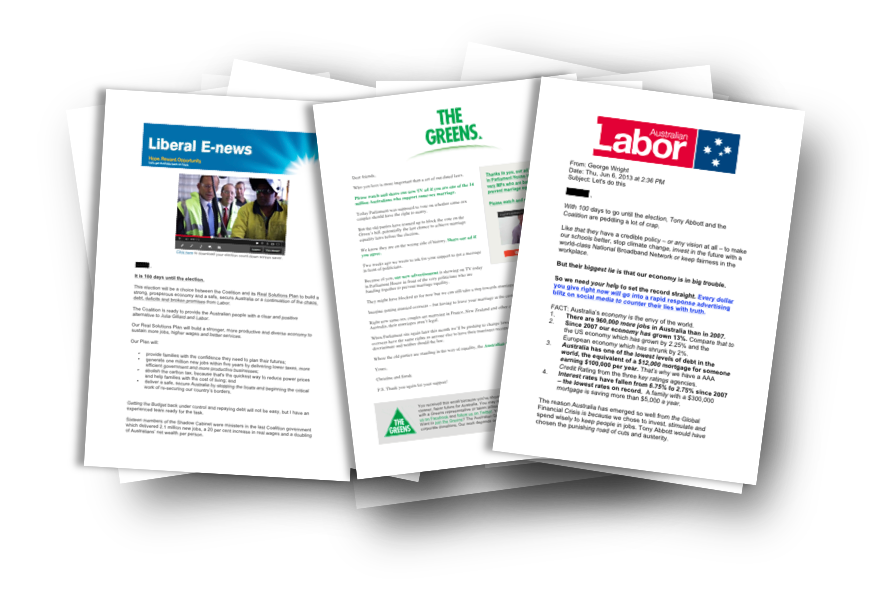JUNE 6 was a milestone of sorts in the 2013 federal election campaign – it marked 100 days until the September 14 poll. [Ed's note: Following the return of Kevin Rudd as Prime Minister, the exact election data is now unknown.]
The political parties did not allow the day to pass unnoticed. The ALP, Liberal Party and the Greens all sent out emails to their several hundred thousand members and supporters.
The primary purpose of the emails is to raise money through political donations. Elections campaigns cost money. Lots of money.
The major parties will spend between $20 and $40 million each on their campaigns. Public funding will provide them with between $20 and $30 million each. This leaves a gap of up to $20 million to fill through fundraising.
This requires a huge effort and time commitment on the part of the politicians and the parties.
One new fundraising technique that has been growing in importance is the harvesting of micro-donations online. This strategy involves the use of social media and email to collect small donations, regularly, from a large number of donors.
While the significance of this method of fundraising is sometimes overstated, it has nonetheless become a crucial way for political parties to fill their campaign war chests.
This has been driven by two main factors: First, the number and size of big donations being made by major donors has declined in recent years. Second, new technology in the form of the Internet, social media and email has made it easier and more effective to solicit and collect large numbers of small donations.
As a consequence, the humble fundraising letter has been reinvented in an email format and is now at the cutting edge of campaign craft and political marketing. The online communication platform means these emails now include video, multiple hyperlinks, online petitions, invitations to join a dialogue or debate and a request to share the message with friends and acquaintances. And of course, fundraising emails make it really easy to hand over your money. Just click on the big red button that says DONATE.
In the modern era, American politician Howard Dean is seen as a pioneer in this field. In his ultimately unsuccessful campaign in the 2004 Democratic Party primaries, he successfully used internet-based fundraising and grassroots organising. The Obama Campaign for the Presidency in 2008 picked many of these techniques up, which in turn made them globally famous, and they are now being used the world over.
A review of the 100-day emails sent out by the ALP, Liberals and Greens shows they are all well versed in this form of campaign communication. The letters also provide an early insight into the market-tested messages and issues that will feature in the campaign.
Rules for an Effective Campaign Fundraising Email
US campaign veteran Mal Warwick has written multiple books on effective fundraising letter writing. The list below draws on several of his articles together with some advice from my own experience.
- Write a letter to just one person - not to "Dear Friends" or "Dear Members". Use the words “I” and “you” (but mostly “you”).
- Ask for a specific gift ... within a specific time period ... for a specific purpose. Repeat the “ask” several times.
- Give your readers a reason to send money immediately. Using a current news event that stirs people’s passions. Linking the donation to the delivery of an immediate responsive action is highly effective.
- Remember how direct mail emails are read: signature first, then the subject line then the first paragraph, perhaps indented paragraphs, underlined words and the P.S. - repetition is not redundant
- Always use a “P.S.” at the end of the body of the email - research shows this is one of the most read parts of a letter.
- Format the email for easy reading - do not feel constrained by traditional rules of grammar and letter writing. But remember to write a letter, not an essay. Use pictures and video to stir people’s passions and motivation to donate.
- Be friendly and informal.
- Before you begin writing, be sure you know who's getting the email: Party members? Supporters? Major donors? Loyal donors? Prospective donors?
- When writing to donors, praise their generosity and loyalty. Highlight the real difference that their contribution has made and will make in the future.
- Organize your letter around one central concept about why the reader should donate, volunteer and share the message.
- Appeal on the basis of benefit, not need. Donors give money because they get something in return (if only good feelings).
The Liberal Party’s 100 Day Email
The letter from the Liberal Party is written by the party’s leader, Tony Abbott, and includes a 40 second music video of Mr Abbott out on the hustings and an Election Countdown Clock that can be downloaded.
Key Coalition messages
- The election is a choice between the Coalition’s plan to build a strong economy and a safe, secure Australia; or a continuation of the chaos, debt, deficits and broken promises from Labor.
- The Coalition Plan will:
- Restore confidence
- Generate one million new jobs and lower taxes
- Abolish the carbon tax
- Stop the boats
- 16 members of the Shadow Cabinet were ministers in the last Coalition Government.
Comment
The Coalition letter makes good use of video, effectively reinforces core campaign messages and includes features like the Countdown Clock that will be appealing to party supporters.
The email seeks to highlight the Coalition’s “Real Solutions Plan”. This policy overview document was released in January and has been heavily promoted since. It is designed to present a positive alternative to the government, but also to counter government claims about Tony Abbott’s negativity and lack of vision or credible policy.
The four points of the plan highlighted in this email are the four issues the Coalition wants the election campaign to be about.
The reference to 16 members of the Shadow Cabinet who served in the former Howard Government fulfils three purposes: First, it highlights the experience of the Coalition to allay concerns about their readiness to govern. This is always a significant hurdle for an Opposition. Second, it highlights the strength of the team as a way of addressing any voter concerns about the leader. Third, it seeks to convert positive voter sentiment about the Howard years into votes for the current Coalition opposition.
The Labor Party's 100 Day Email

The letter from the ALP comes from Campaign Director, George Wright, and does not mention Julia Gillard or the Gillard Government.
Key Labor messages
- Tony Abbott and the Coalition are “peddling a lot of crap”.
- Stand up and join the fight. Australia can’t afford for Labor to lose.
- The letter identifies the key issues where Labor believes the Liberals do not have a credible policy or vision:
- Making schools better
- Stopping climate change (although no mention of the carbon price)
- A world-class National Broadband Network
- Fairness in the workplace
- The economy: Australia’s economy is the envy of the world, thanks to Labor.
Comment
The email effectively evokes the tradition of the Labor movement “fighting for justice” and translates this into the current campaign setting.
The email acknowledges that Labor has significant challenges at the September poll – the “lies and attacks have a lot of people feeling worried”. The email focuses on Tony Abbott, in order to tap into any concerns about his leadership.
The five policy areas listed in the email are the five issues that Labor wants the campaign to be about.
The letter utilises many of the tips for fundraising letters covered earlier. This includes an urgent call to action with a donation to a “rapid response advertising blitz on social media”.
The Greens 100 Day Email
The Greens email comes from party leader Christine Milne and Greens Senator Sarah Hanson-Young.
The email makes no reference to the 100-day election milestone. Instead, it highlights that on that day the House of Representatives was due to vote on a Greens bill for marriage equality, but the vote was blocked by the “old parties”.
The email includes video of an ad that was running on TV that day and multiple hyperlinks to solicit commitments from people to further action.
Key Greens messages
- The old parties have teamed up to block the vote on the Greens bill on marriage equality.
- Your contribution is important: “because of you, our new advertisement is showing on TV today in Parliament House.”
- Share our ad if you agree.
- The Australian Greens are fighting for what matters. If you care, Vote Green.
Comment
The email effectively uses an event in parliament to rally support on an issue the Greens know their members and supporters feel strongly about. The parliamentary Greens and their campaign operation have worked closely together to turn an event into an immediate fundraising and marketing opportunity.
By booking an ad on SKY News, the Greens have used a trick from the modern campaign playbook. SKY News has low ratings which means its advertising rates are relatively cheap. However, SKY News is watched by politicians in parliament house because of its 24 hour news service and heavy focus on federal parliament. This allows the Greens, at little expense, to boast that: “Thanks to you, our ad is on TV today in Parliament House in front of the very MPs who are banding together to prevent marriage equality.
Suggest a story | Email the editors | About Election Watch
Images policy | To republish | Twitter | Facebook




